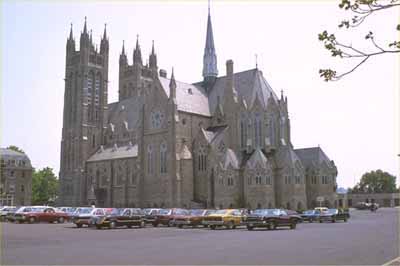Our Lady of the Immaculate Conception National Historic Site of Canada
Guelph, Ontario

Corner view of side and rear
© Parks Canada Agency / Agence Parcs Canada, 1991.
Address :
50 Norfolk Street, Guelph, Ontario
Recognition Statute:
Historic Sites and Monuments Act (R.S.C., 1985, c. H-4)
Designation Date:
1990-02-23
Dates:
-
1876 to 1888
(Construction)
-
1925 to 1926
(Significant)
Event, Person, Organization:
-
Joseph Connolly
(Architect)
Other Name(s):
-
Our Lady of the Immaculate Conception
(Designation Name)
-
Church of Our Lady of the Immaculate Conception
(Plaque name)
Research Report Number:
1989-SUC
Plaque(s)
Existing plaque: Inside the rectory office of the church Norfolk Street across from Macdonell Street, Guelph, Ontario
Our Lady of the Immaculate Conception is an exceptional example of the High Victorian Gothic Revival style, an architectural movement that was international in scope. The design of this church was inspired by the medieval cathedrals of France. Characteristic of the style are the twin towers, large rose window, pointed windows and an interior plan featuring chapels that radiate from the apse. Constructed in several stages beginning in 1876, the church was designed by Irish-born Joseph Connolly, the principal architect for the Roman Catholic Church in late-19th century Ontario.
Description of Historic Place
Inspired by the medieval cathedrals of France, the twin towers of this large stone church rise above the city centre in Guelph, Ontario. Constructed as the centrepiece of a complex of Roman Catholic religious and educational buildings, the church is prominently situated on the brow of a hill. It features elements inspired by the French Gothic Revival, including, a twin-towered facade, a large rose window and a polygonal apse with radiating chapels. The formal recognition consists of the church building on its footprint.
Heritage Value
Our Lady of the Immaculate Conception was designated a National Historic Site in 1990 because: it is an exceptional example of the High Victorian Gothic Revival style in Canadian architecture.
Unlike the earlier, Ecclesiological phase of Gothic Revival, during which architects were restricted to certain correct precedents, the High Victorian Gothic Revival gave architects freedom to draw inspiration from a wide variety of periods and countries, while still following certain established principles as to composition and structure. Like many churches designed by English-speaking architects in the late19th century, the design of Our Lady of Immaculate Conception shows the strong influence of the French Gothic Revival. Designed by Joseph Connolly, the principal architect for the Roman Catholic church in Ontario, Our Lady of Immaculate Conception incorporates French Gothic Revival features, such as a twin-towered façade, rose windows and a polygonal apse with radiating chapels. Built in 1876-1888 with towers completed in 1925-1926, the church is considered to be Connolly’s best work.
Source: Historic Sites and Monuments Board of Canada, Minutes, October 1990.
Character-Defining Elements
Key elements contributing to the heritage value of Our Lady of the Immaculate Conception include: its High Victorian Gothic Revival style, evident in its plan, composition, façade, and architectural details inspired by the French Gothic Revival, including a cruciform plan with side aisles, prominent nave, triforium arcades, apse with radiating chapels and ambulatory, twin-towered façade, spire at the central groin vault, and large rose windows; the sense of verticality, created by the use of steeply pitched roofs with gables, dormers, pinnacles, pointed arches, and tall narrow window openings; the symmetrically organized façade with its twin square towers with pinnacles and paired openings, massive rose window with bar tracery set in a moulded pointed arch, row of lintel statuary set within a blind arcade, and carved tympanum; the division of side elevations into bays defined by engaged buttresses, with each bay accented by a pointed arch and a stained glass window; the north and south transepts, each distinguished by two lancet windows below a large, stained-glass, rose window with flanking narrow pinnacles; the polygonal apse, comprised of radiating gabled chapels with another level of gables above; the extensive use of pointed arches and stained glass windows with bar tracery throughout the composition; the Gothic Revival styling of the interior, including, tall pointed-arch windows in the chancel, clerestories inset with rose windows, stained-glass windows, nave-arcades with false triforium-galleries, granite columns with acanthus capitals supporting the aisle arcades, and rib vaulting; the high quality design and craftsmanship of its interior, including its wood and stone carving, its stained glass, its stencilling, its ironwork, its mosaics, and its excellent acoustics; its prominent siting at the top of a hill overlooking the city; viewscapes to and from the church and the city.